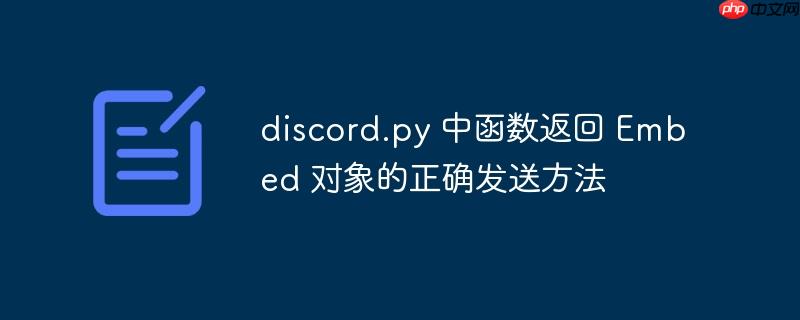
本教程详细讲解了在 discord.py 中如何正确发送从函数返回的 discord.Embed 对象。许多开发者在将 Embed 对象封装到函数中并尝试发送时,常因忽略 channel.send() 方法中的 embed 关键字参数而遇到问题。本文将通过具体代码示例,指导您如何避免此常见错误,确保动态生成的 Embed 消息能够被 Discord 正确渲染显示,从而提高代码的可维护性和复用性。
模块化 Embed 的优势
在 discord.py 机器人开发中,将 Discord Embed 消息的创建逻辑封装到单独的函数或模块中是一种推荐的做法。这种模块化设计带来了多重好处:
- 代码复用性: 避免在不同地方重复编写相似的 Embed 创建代码。
- 可维护性: 当需要修改 Embed 的样式或内容时,只需在一个地方进行更改。
- 代码清晰度: 将复杂的 Embed 构建逻辑从主业务逻辑中分离,使代码更易读、更易管理。
- 动态内容: 可以通过函数参数轻松地为 Embed 注入动态数据。
常见问题:未正确发送 Embed 对象
开发者在尝试将函数返回的 discord.Embed 对象发送到 Discord 频道时,常会遇到一个问题:消息中显示的是
这通常发生在以下情况:
# _embeds.py (假设这是一个独立文件,用于定义Embed创建函数) import discord from datetime import datetime def setting_update_success(setting, value): embed = discord.Embed(title="成功!", description=f"设置 `{setting}` 已更新为 `{value}`。", colour=0x19e63b, timestamp=datetime.now()) # 示例中的作者和页脚可以根据实际需求添加或省略 # embed.set_author(name="Chix", icon_url="attachment://chix_full.png") # embed.set_footer(text="发送成功") return embed # main.py (在主程序中调用) import discord # 假设 messages 是 _embeds.py 模块的别名 # from _embeds import setting_update_success as messages # 实际导入方式 # 或者直接导入整个模块 import _embeds as messages async def send_message_incorrectly(channel: discord.TextChannel): # 错误示例:直接将函数调用结果作为 channel.send() 的第一个参数 await channel.send(messages.setting_update_success("通知", "开启"))
上述代码的问题在于 channel.send() 方法的第一个参数默认是用于发送普通文本消息的。当您传入一个 discord.Embed 对象时,python 会将其转换为字符串表示形式,而不是将其作为 Embed 消息发送。
解决方案:使用 embed 关键字参数
discord.py 的 TextChannel.send() 方法提供了一个名为 embed 的关键字参数,专门用于发送 discord.Embed 对象。要正确发送 Embed 消息,您需要将函数返回的 Embed 对象赋值给这个参数。
# main.py (在主程序中调用) import discord import _embeds as messages # 假设 _embeds.py 模块已导入 async def send_message_correctly(channel: discord.TextChannel): # 正确示例:使用 embed 关键字参数 await channel.send(embed=messages.setting_update_success("通知", "开启"))
通过使用 embed= 参数,discord.py 知道您要发送的是一个嵌入式消息,并会正确地对其进行处理和渲染。
完整示例:在独立文件中管理 Embed
为了更好地展示如何组织代码,以下是一个更完整的示例,包括一个独立的 _embeds.py 文件和一个 main.py 文件。
_embeds.py 文件内容:
import discord from datetime import datetime def create_success_embed(setting: str, value: str) -> discord.Embed: """ 创建一个表示设置更新成功的 Embed 消息。 Args: setting (str): 被更新的设置名称。 value (str): 设置更新后的值。 Returns: discord.Embed: 构建好的 Embed 对象。 """ embed = discord.Embed( title="操作成功!", description=f"设置 `{setting}` 已成功更新为 `{value}`。", colour=discord.Colour.green(), # 使用 discord.Colour 枚举更清晰 timestamp=datetime.now() ) # 可以添加作者、缩略图、图片、字段等 # embed.set_author(name="机器人助手", icon_url="URL_TO_YOUR_BOT_AVATAR") # embed.add_field(name="详情", value="更多信息可以在这里添加。", inline=False) return embed def create_error_embed(error_message: str) -> discord.Embed: """ 创建一个表示操作失败的 Embed 消息。 Args: error_message (str): 错误信息。 Returns: discord.Embed: 构建好的 Embed 对象。 """ embed = discord.Embed( title="操作失败!", description=f"发生错误:{error_message}", colour=discord.Colour.red(), timestamp=datetime.now() ) return embed
main.py 文件内容:
import discord from discord.ext import commands import _embeds # 导入包含 Embed 函数的模块 # 假设您的机器人令牌 TOKEN = "YOUR_BOT_TOKEN" # 创建一个 Bot 实例 intents = discord.Intents.default() intents.message_content = True # 如果需要读取消息内容 bot = commands.Bot(command_prefix='!', intents=intents) @bot.event async def on_ready(): print(f'Bot 已登录为 {bot.user}') @bot.command(name='set') async def set_command(ctx, setting: str, value: str): """ 一个示例命令,用于模拟设置更新并发送成功或失败的Embed。 使用方法: !set <设置名称> <值> """ try: # 模拟一些业务逻辑,例如将设置保存到数据库 print(f"尝试更新设置: {setting} 为 {value}") # 假设更新成功 success_embed = _embeds.create_success_embed(setting, value) await ctx.send(embed=success_embed) # 正确发送 Embed except Exception as e: # 假设更新失败 error_embed = _embeds.create_error_embed(f"无法更新设置:{e}") await ctx.send(embed=error_embed) # 正确发送 Embed @bot.command(name='test_error') async def test_error_command(ctx): """ 测试发送错误 Embed 的命令。 """ error_embed = _embeds.create_error_embed("这是一个模拟的错误信息。") await ctx.send(embed=error_embed) # 运行机器人 if __name__ == '__main__': bot.run(TOKEN)
在这个示例中,main.py 通过 import _embeds 导入了包含 Embed 创建函数的模块。然后,在命令处理函数中,我们调用 _embeds.create_success_embed() 或 _embeds.create_error_embed() 来获取 Embed 对象,并使用 await ctx.send(embed=…) 来正确发送它们。
最佳实践与注意事项
- 始终使用 embed= 参数: 这是发送 discord.Embed 对象的唯一正确方式。
- 参数化 Embed 函数: 将 Embed 中需要动态变化的部分作为函数参数传入,例如 title、description、fields 的值等,这样可以极大地提高 Embed 的灵活性和复用性。
- 明确函数返回值类型: 在 Python 3.5+ 中,可以使用类型提示(如 -> discord.Embed)来明确函数将返回一个 discord.Embed 对象,这有助于代码的可读性和 ide 的自动补全。
- 错误处理: 在实际应用中,处理可能发生的错误并发送相应的错误 Embed 消息是良好的实践。
- Embed 数量限制: Discord 允许在一条消息中发送最多 10 个 Embed。如果需要发送多个 Embed,可以将它们放入一个列表中,然后通过 embeds 关键字参数发送(await channel.send(embeds=[embed1, embed2]))。
总结
将 discord.Embed 对象的创建逻辑封装到函数中是提高 discord.py 机器人代码质量的有效方法。核心要点在于,当您从函数中获取一个 discord.Embed 对象并希望将其发送到 Discord 频道时,务必使用 channel.send() 方法的 embed 关键字参数。通过遵循这一简单而关键的原则,您可以确保您的机器人能够清晰、专业地展示信息,从而提升用户体验。



















